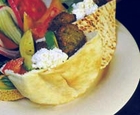|
Mid-East Appetizer Chickpea Patties These seasoned chickpea patties are fried then tucked into pita pockets and topped with yogurt, diced tomatoes, cucumber and lettuce.
Patties: soak dried peas overnight in a bowl covered by 2" of water. The next day, combine peas (do not drain them) in a large bowl with remaining ingredients, except frying oil. In a food processor, process (in batches) to a moist, grainy texture. Mix all batches together in another large bowl and form into 32 walnut-sized balls. Flatten the balls into little patties. Frying: in a heavy skillet, heat the oil for frying. Cook the falafel patties till brown on one side, flip and cook till nicely browned on and cooked throughout. Drain on paper towels. Serving: falafel is often served inside pita pockets: slice a large-sized pita pocket in half. Add 3 or 4 patties to each half and top them with finely chopped tomato and yogurt. Add finely chopped cucumber and shredded lettuce. * You can also buy a ready-made falafel mix at any Mid-east market. You just add water and shape into patties. |
Tips & Glossary Many of the ingredients used for Middle-Eastern cooking may not be in your spice shelf, but you can find them at Mid-Eastern food stores. So to avoid frustration, make a list of the items you need before trying out the recipes. Toss any old, even unopened, spice jars because they’ve probably lost their distinctive flavors. Put them on your shopping list. Bulgur Wheat: wheat grains that have been par-boiled, dried, and de-branned. Bulgur has a high fiber content and wonderfully nutty flavor. Cardamom: related to ginger. Pods (green, brown, or black) are the best way to store the spice, although high-quality ground is readily available. A equivalency: 10 pods = 1½ tsp. ground cardamom. Coriander: aka cilantro, Chinese, or Mexican parsley. Fresh leaves and dried ground seeds are used in Mid-East, Asian, Indian, and Mexican cuisines. Cumin: related to parsley and carrot plant; an important ingredient in chili powder. Used especially in curries, but also in Mid-Eastern, Mexican and Asian dishes. Cumom has an earthy, peppery flavor. Deep Frying: oil must be hot enough; otherwise food will be soggy and greasy. Use a deep-fry thermometer to ensure proper temperature is reached. When cool, oil can be strained, refrigerated, and re-used. Filo: aka phyllo; paper-thin sheets of raw, unleavened flour dough. Purchase frozen in any grocery store and follow directions on package for thawing. When working with one sheet, keep others covered with a damp towel to prevent drying out. Rosewater: distilled from rose petals and used to flavor Mid-Eastern and Asian cooking. You can make your own—but why? Purchase it at Asian or Middle Eastern food stores. Semolina flour: made from hardy durum wheat. A yellowish flour, it's used in Asian and Mid-East cooking (couscous). In the U.S., it's Farina, a breakfast cereal. Tahini: paste from ground, hulled sesame seeds. A major ingredient in hummus and other Mid-Eastern and Asian foods, you can purchase at most grocery stores.
|
Site by BOOM
![]()
LitLovers © 2024

